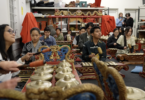Getting people to donate to charity is hard.
The most successful organisations use a variety of clever tactics, from street-level ambushes by British backpackers, to eliciting sympathy with images of malaria-stricken children.
Still, it’s never a walk in the park.
“People want to help,” says Adam Robinson, “but you have to give them an easy way to do so.”
Twelve years ago Robinson found a way. The result was DineSmart.
The concept is simple: at participating restaurants, cafes and bars, patrons are asked to leave an extra $2 with their bill, which goes towards local charities.
The initiative has since raised more than three million dollars, and will run from November 10 to December 31 this year, with venues across the country taking part.
It’s clever, really. Is there a time when people are more accommodating, more generous and at ease, than when they’ve just finished a nice meal and a few drinks?
It beats the hell out of ambushing stressed white collars on their way back to work after a hasty sandwich.
Earlier this year, Robinson ran a similar program called CafeSmart, which saw cafes donate $1 with every coffee they sold.
Both initiatives come under the umbrella of StreetSmart, the charitable organisation he founded in 2003.
“I was working in a small youth service at the time,” Robinson says, “and realised just how difficult it was for smaller charities and not-for-profits to raise funds.”
Big NGOs such as World Vision and Red Cross, he says, have the largest advertising budgets and public profiles.
Consequently, they attract the bulk of public donations.
This is good, of course, but it often leaves small community organisations in the lurch.
“It’s a big issue for the sector,” Robinson says.
“It costs money to raise money; there’s no doubt about it.”
At the aforementioned NGOs, this fact is often to the detriment of donors, whose money ends up being spent on administration or advertising.
In 2011, for instance, World Vision spent $37.7 million on advertising, and this year, it will use just 83 per cent of donations to fund projects directly.
At StreetSmart, that figure is 100 per cent, thanks to corporate sponsors and private philanthropists, who pay administration and advertising costs so the public don’t have to.
This, and the sheer simplicity of adding $2 to the bill, has made DineSmart a raging success.
Last year it raised $445,921, up from $370,167 in 2013.
“I think people approach it as ‘Why not?'” Robinson says.
Venues have a similar attitude, given the money they raise stays local – within the immediate suburbs, usually.
At last count, DineSmart had funded 845 such projects, including homeless shelters, free meal services, kids’ camps and prison reform programs.
“One that always sticks in my mind is the Street Socceroos program at The Big Issue,” Robinson says.
Eight years ago, he gave the struggling magazine $1200 to set up a soccer league for its homeless vendors.
“Since then, they’ve helped thousands of people, they’re federally funded and the soccer program runs in 30 cities and towns around the country,” he says.
DineSmart, he believes, is the best way for people to support these types of organisations, which they “sometimes don’t even know exist.”






